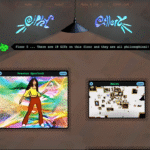
This isn’t the first time we’ve seen studios take inspiration from a building’s old signage. In 2017 the design and letterpress studio The Counter Press rebranded London’s famous Bibendum restaurant, with a typeface that drew directly on the art-nouveau building’s unique, 3D tiled sign, and earlier this year we spoke to Kevin Högger about his identity for Belmondo restaurant, which saw him base a new lettering system on the eatery’s old neon signage. Like the Fonda Europa project, they prove that revamping is just as impactful as starting afresh.
To modernise the inspired typeface, the team moved away from the stasis of the original signage and tried to make the font as flexible as possible. As the font was just a display typeface – which Andrés recognises not to be “very rigorous” – the team aimed to create a sense of vibrancy as opposed to something highly technical. Through the identity the typeface playfully stretches and condenses, creating difference between each of the glyphs, meaning subtly different letter systems can be used across various graphic elements, like menus, business cards and social assets. With the font taking centre stage throughout the rebrand, this variation helps to ensure an element of versatility and unpredictability, especially as it doesn’t feature any illustrative elements.
The type is then paired solely with a bold, bright and sunny yellow and high contrast flash photography, another creative choice that helps to bring the restaurant up to the present day. High energy shots show people walking with takeaway bags, handing over business cards and perusing the menu. Overall, Andrés sees the rebrand as being successful where it matters, having captured the historical spatial spirit of the restaurant, while bringing it firmly into the present day.











